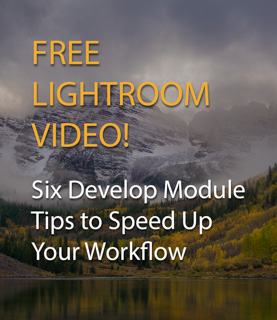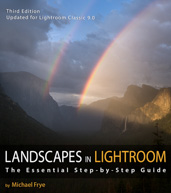In the Moment:
Michael Frye's Landscape Photography Blog
by Michael Frye | Nov 27, 2019 | Announcements
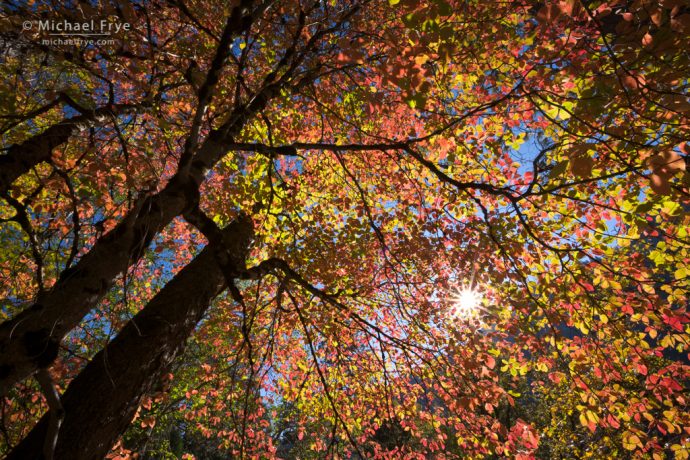
Sunlit dogwoods, autumn, Yosemite
Thanksgiving is a day for gratitude. While I think we should be grateful every day, it’s nice to take one day to be especially mindful of everything we have to be thankful for.
As I’m writing this I can look out my window and see five inches of fresh snow on the ground. After a dry, warm autumn, it feels as if the weather changed directly from summer to winter. This cold storm is going to cause problems for holiday travelers, but I’m thankful for the badly-needed rain and snow our state is receiving. Fire season is finally over, and further storms are on the way, bringing more beautiful moisture.
(more…)
by Michael Frye | Nov 17, 2019 | Vision and Creativity
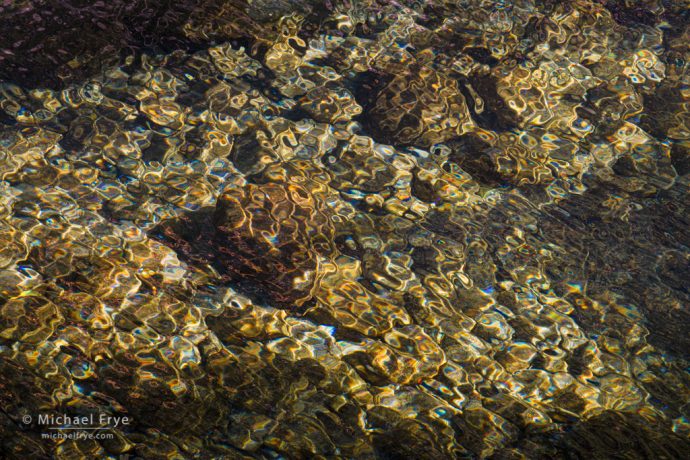
Rocks and ripples in the Merced River, Yosemite. Claudia, Charlotte Gibb, and I noticed some interesting patterns in the water while wandering along the river last year. I made a few compositions at one spot, then moved downstream, where I found Claudia and Charlotte looking at similar patterns with prism effects – little squiggly rainbows flashing across the water. I made a couple of photographs I liked last year, but then went back to that same spot last month, and this time found a sunlit patch of water surrounded by tree shadows, which gave the pattern a natural vignette. I needed a fast shutter speed to freeze the motion of the ripples, and a small aperture to keep everything in focus, so I raised the ISO to 1600 to get the shutter speed up to 1/125th sec. at f/16. The focal length was 200mm.
Landscape photographers usually hope for great conditions: a clearing storm, sun breaking through fog, a spectacular sunset, great fall color, dense patches of wildflowers, and so on.
I wouldn’t say it’s easy to make good photographs under such conditions. You still have to put yourself in the right place at the right time, find a good composition, and get the exposure and focus right. And all of those things take skill. But it’s certainly easier. In those highly-photogenic situations you just have to capture the gift that nature is giving you.
(more…)
by Michael Frye | Nov 13, 2019 | Announcements
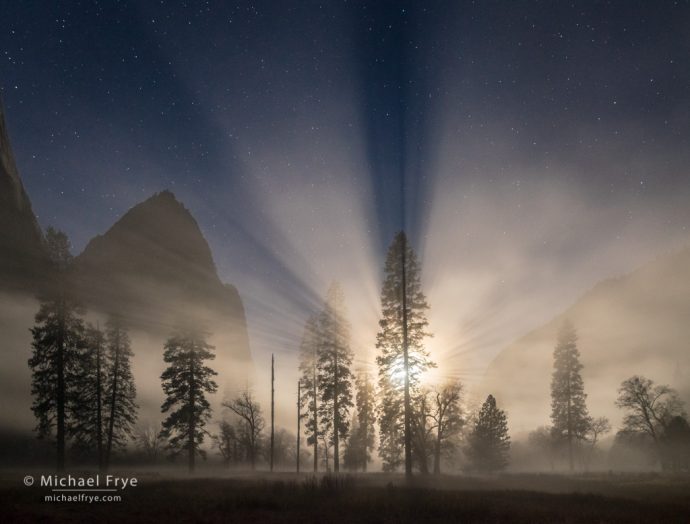
Moon setting on a misty night, El Capitan Meadow, Yosemite. I’ve photographed Yosemite Valley many times, but on this night several years ago I found something I had never seen before: moonbeams radiating through the mist in El Cap Meadow.
I had a great time talking with Matt Payne recently on his F-Stop, Collaborate, and Listen podcast. The episode was just released today, so you can listen to it on your favorite podcast platform, or directly on Matt’s website.
We talked about all kinds of things – my connection with Yosemite, early influences, the challenges and rewards of photographing the same place over and over again, obstacles to creativity, ways to create depth in landscape photography, and more. I hope you enjoy the podcast!
(more…)
by Michael Frye | Nov 10, 2019 | Light and Weather, Vision and Creativity
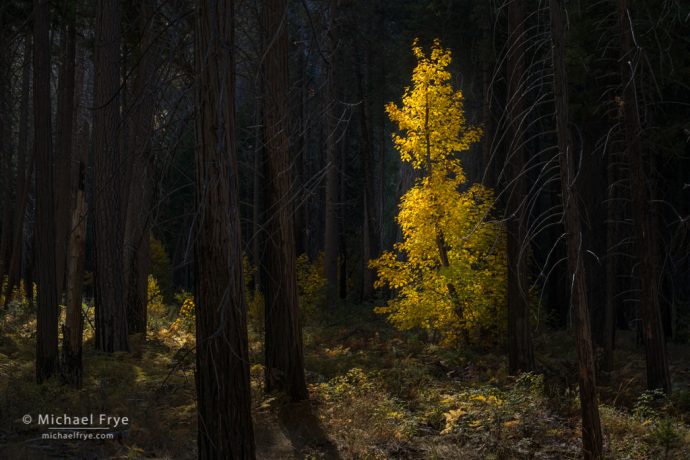
Big-leaf maple in a burned forest, Yosemite
I’m always striving to make photographs that convey a mood. I want to do more than show what a place looks like; I want to capture what it feels like to be there at that particular moment.
It seems easier to convey a mood when photographing big landscape scenes during interesting weather. Just describing any kind of weather suggests a mood: sunny, cloudy, gray, overcast, rainy, foggy, misty, snowy, windy, calm – and so on. Combining weather with a compelling landscape almost automatically creates a mood.
(more…)
by Michael Frye | Nov 3, 2019 | Composition
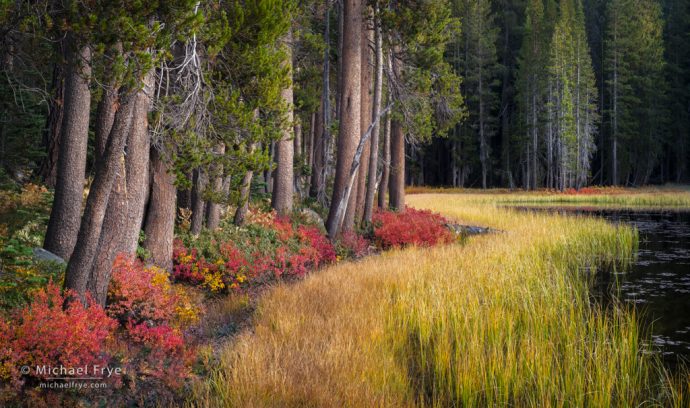
Autumn lakeshore, Yosemite. 50mm, 1/2 sec. at f/16, ISO 100, polarizer.
I sometimes get asked to recommend a book about composition, and my first suggestion is always Ian Plant’s ebook Visual Flow. Ian understands composition well, presents his concepts clearly, and doesn’t have much use for rules.
The title of the book suggests an important concept, but one that’s often overlooked. I think the best landscape compositions have a natural visual flow. Your eye doesn’t get stuck, but travels freely through the frame, pausing briefly at the key areas.
(more…)
by Michael Frye | Oct 27, 2019 | Composition
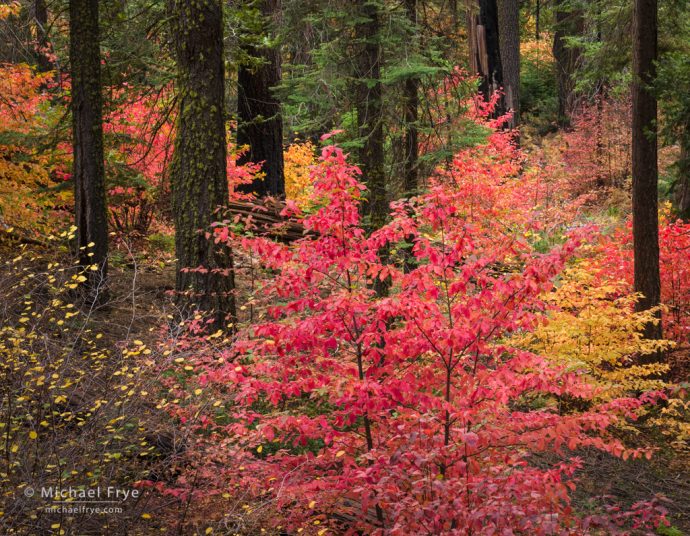
Dogwoods in autumn, Yosemite. 118mm, 1/2 sec. at f/16, ISO 1600.
Are you good at picking your best photographs while you’re in the field? Do you always know which ones are going to be your favorites, or do you sometimes find that the ones you thought were going to be great aren’t, while others turn out to be better than you thought?
I’ve been making photographs for a long time, and usually have a pretty good idea of when a photograph will work and when it won’t. Sometimes my field judgements are pretty good, and the images that I most look forward to seeing on a bigger screen turn out to be my favorites. But other times I’m surprised. A photograph I was anxious to see on a large monitor turns out to be disappointing, while another one ends up being a favorite.
(more…)
by Michael Frye | Oct 20, 2019 | Light and Weather
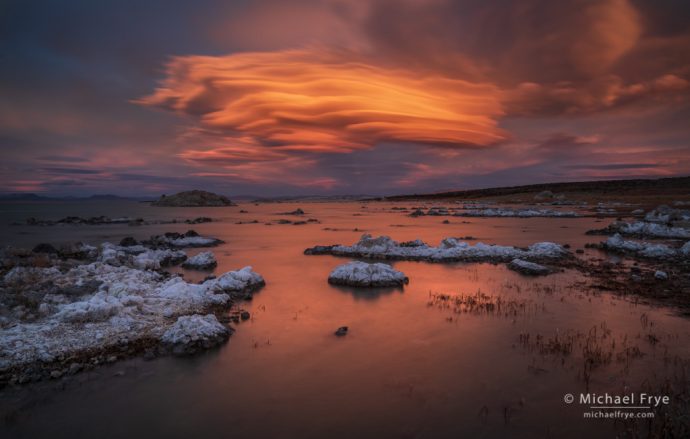
Lenticular cloud at sunset, Mono Lake, California. 20 seconds at f/14, ISO 100, 7-stop ND filter.
We just finished our workshop in the eastern Sierra, and had a great time. We had to look a little harder for colorful aspens this year, but in the end we found plenty.
The workshop ended on Friday. Yesterday Claudia and I slept in a bit, then did an interview, packed up our classroom space from the workshop, and had an early dinner at the Whoa Nellie Deli in Lee Vining.
(more…)
by Michael Frye | Oct 13, 2019 | Light and Weather, Travels and Stories

Autumn kaleidoscope, northern Utah. The upper-right portion of this photograph didn’t go into the shade until dusk, so I concentrated on photographing other things for awhile (like the next two images below). But I thought this was worth coming back to, as I loved the mix of colors and patterns. 180mm, 8 seconds at f/11, ISO 100.
As you can probably tell from my last post, Claudia and I had a great time photographing the maples in northern Utah. We even found some spots where the maples were mixed with aspens! Although 99% of the aspens in the area were still green at that time, I loved the juxtaposition of those greens against the reds and oranges of the maples – along with the white aspen trunks.
It’s great to get clouds, as we did for a couple of the photographs in that previous post from Utah. But we don’t have any control over the weather, so we have to adapt to the conditions. It’s hard to make big, sweeping landscape scenes work without clouds to add interest to the sky, so on sunny days I usually narrow my focus and concentrate on smaller scenes. And there were plenty of those in northern Utah, with the maples, aspens, and cottonwoods creating wonderful patterns, textures, and colors.
(more…)
by Michael Frye | Oct 6, 2019 | Travels and Stories
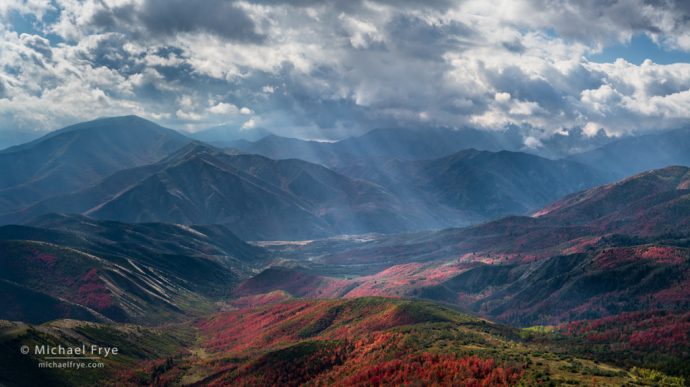
Sunbeams, mountains, and autumn maples, Utah. We were treated to some spectacular sunbeams one morning. Despite the high contrast, I was able to get detail in highlights and shadows with just one exposure. 50mm, 1/250th sec. at f/11, ISO 100, polarizer.
Claudia and I were driving to Colorado when we decided to take a little detour to the Wasatch Mountains in Utah. We’d never been there, and it looked like the bigtooth maples were nearing their peak color, so why not?
The maples, as it turned out, were spectacular, covering the hillsides with red. I’d never seen anything like it. And one day we got treated to some interesting weather, with clouds, mist, and sunbeams.
(more…)
by Michael Frye | Sep 15, 2019 | Smartphone Photography
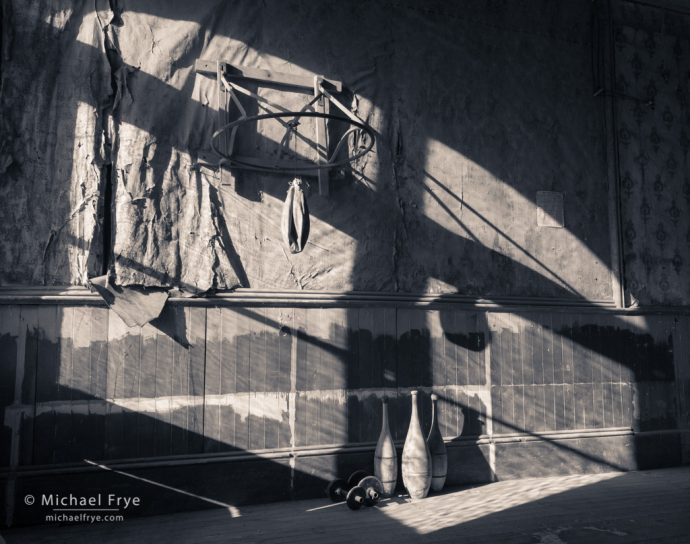
I.O.O.F. Hall, Bodie SHP, California. I love to photograph the light streaming through the windows of the curtain-less, abandoned interiors of Bodie.
Bodie is such a fun place to photograph. I had a chance to go back to Bodie at night in early August, and then at the end of August we were able to get inside some of the normally-inaccessible interiors during our good friend Robert Eckhardt’s iPhone-photography workshop.
Smartphone cameras keep getting better and better. This time I was using an iPhone XR, which performs much better in low light than my previous iPhone. And I mostly used raw mode to get the best image quality and the most flexibility in processing the images.
(more…)











